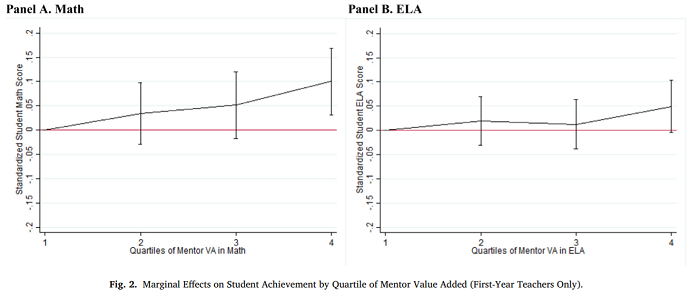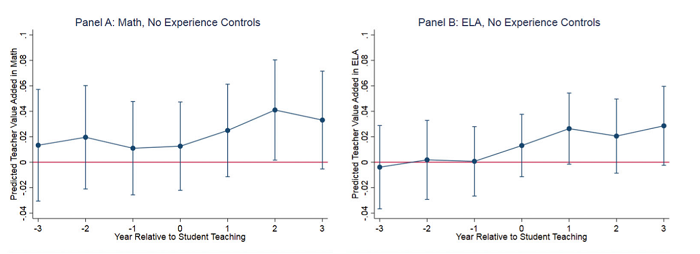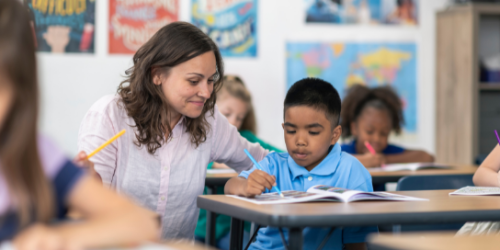For the past year and a half, school districts have faced unprecedented challenges, ones that will affect not only current students and teachers, but new teachers for years to come. While districts deal with numerous immediate needs in order to open doors this year, turning some attention to student teachers could greatly help both in the short and long term, using strategies proven by research to work!
In surveys, teachers have reported that the most important part of their preparation was the student teaching experience.1 And research bears that out. When designed well, student teaching can make teachers more effective in their first year. Read on for six steps a school district can take to use student teaching to their advantage.
1. Pair student teachers up with the strongest current teachers.
While it may be tempting to pair a struggling teacher with a student teacher, think again.
Pairing student teachers up with less effective teachers is actually worse for everyone. To make student teaching a win, schools and districts should recruit the most effective teachers to mentor the novices.
A large amount of recent research has demonstrated that student teachers who are paired with a more effective cooperating teacher are more effective in their first year of teaching. One study found that the difference in outcomes for a student whose teacher trained under a highly effective cooperating teacher versus an average one is equivalent to the difference in outcomes for a student taught by a third-year teacher versus a brand new one.

The above figure illustrates that having a more effective mentor teacher (measured by their quartile of value-added scores on the X axis) is associated with greater gains for the student teacher’s future students (as measured by the Y axis).2
Another study found that student teachers having effective cooperating teachers was associated with a six-month head start in terms of teacher effectiveness. In fact, research out of North Carolina found that pairing student teachers with strong cooperating teachers is even more important for student teachers who aren’t quite as strong academically.
2. Use easy, low-cost strategies to recruit strong cooperating teachers.
Of course, being a cooperating teacher brings additional work and responsibility. Many district and school leaders fear that there are not enough effective teachers to go around. To the contrary, an analysis of teachers in Washington state found that only a small portion of available effective and highly effective teachers are tapped to be cooperating teachers.
Even better news is that there’s a simple, low-cost way that districts can help recruit effective teachers. In an experimental study in Tennessee, researchers gave the university supervisor of student teaching at one institution an ordered list of the best available teachers in the region, based on their instructional performance (measured by value-added and observation ratings), years of experience, and placement information (i.e., grades and subjects taught). In comparison to business as usual, the recruited cooperating teachers were much more effective and student teachers reported feeling better prepared to teach. No additional incentives were offered, and no outside researcher was needed; school districts themselves can create these lists and provide them to local preparation programs.
Effective teachers may be concerned that hosting a student teacher could hurt their students’ growth or their own evaluation ratings. In fact, on average, neither of these negative outcomes come to pass. A study out of Tennessee found that cooperating teachers suffered no harm to their ratings or to their students’ learning, while another study from Washington state found that, on average, only less effective teachers saw their evaluation ratings drop—another reason to restrict cooperating teacher positions to more effective teachers.
Perhaps even more exciting, another study found that while hosting a student teacher had no impact on student achievement during the host year, that cooperating teacher’s students showed greater achievement gains in the following years.

This figure shows that after hosting a student teacher (Year 0), cooperating teachers’ average VAM score trends upward, though the change only reaches statistical significance in math.3
3. Host student teachers in the areas that will help meet staffing challenges.
While new teachers are likely to take their first job near their home, they’re ten times more likely to take a first job near where they student taught. If a school or district anticipates needing to hire teachers next year, they should make sure to host student teachers this year.
Hosting student teachers with an eye to hiring them may stave off potential teacher shortages. Districts that host more student teachers have fewer teachers with emergency credentials, in a study of Washington state school districts. This relationship held up even after controlling for geography, demographics, and the distance to the local teacher prep programs, meaning that two similarly rural districts saw different rates of emergency-credentialed teachers depending on how many student teachers they hosted. Essentially, while hosting student teachers does take some work for the district, it offers a huge potential upside to securing qualified teachers.
4. Use aligned student teaching experiences to amp up effectiveness.
Bringing student teachers into the subjects, grades, and schools where districts anticipate upcoming openings offers more than just a means to fill vacancies. The more closely aligned a student teacher’s experience is with her first job, the more effective she will be from day one.
Not surprisingly, teachers whose student teaching placement was in the same grade as their first year of teaching assignment tend to be more effective as well.
Aligning experiences can also support teacher retention. Novice teachers who teach in the same school type (elementary, middle, or high) as their student teaching placement are five percentage points less likely to leave the workforce than those who student taught in another school type. Also, new teachers whose classrooms and schools have similar poverty levels as their student teaching placements are less likely to leave the workforce than teachers who experience a greater mismatch.
5. Pay close attention to the socioeconomic factors of the schools and classrooms in which student teachers are placed.
Aspiring teachers tend to student teach in classrooms that are more affluent than the classrooms in which they’re first hired—a mismatch that is especially harmful to teacher effectiveness. One study found when teachers had a larger difference between the percentage of low-income students from their student teaching experience to their first job, their students experienced lower math and ELA scores.
6. Look for effective student teachers, since they’re more likely to be effective new teachers.
Districts often invite teacher applicants to teach a sample lesson, but imagine how much more insight can be gained from seeing student teachers at work across weeks of instruction. Even though student teachers are still learning and developing their craft, a study out of Germany found that a student teacher’s performance was the most predictive of later classroom effectiveness.
To identify these promising teachers, districts should make sure student teachers get evaluated on their schools’ standards. The accuracy of student teacher ratings depends a lot on the quality of the process for training evaluators, and this process may vary. If a district hopes to hire from the pool of student teachers, they may get the best read by looking at student teacher performance based on district expectations.
In sum, student teaching can be a powerful tool to bring in new cohorts of teachers. When designed well, and with little additional time or money, student teaching can help identify potentially great new teachers, give them experiences in the types of schools where they are likely to be hired, and help them learn from a district’s most effective teachers. It’s a win for the student teachers, a win for schools and districts, and a big win for the students who will be in their classrooms the next year.
More like this

Lamenting the poor lot of student teaching
When we sow benign neglect, it’s no wonder we reap mediocrity.

High-quality student teaching placements, and who stands to benefit the most
A new study adds to the mix research that unpacks which candidates particularly benefit from high-quality student teaching placements.
Endnotes
- Levine, A. (September 2006). Educating school teachers (p. 39). Washington, DC: The Education Schools Project.
- Graphs from Goldhaber, D., Krieg, J., & Theobald, R. (2020). Effective like me? Does having a more productive mentor improve the productivity of mentees? Labour Economics, 63, 101792.
- Graphs from Goldhaber, D., Krieg, J. M., & Theobald, R. (2020). Exploring the impact of student teaching apprenticeships on student achievement and mentor teachers. Journal of Research on Educational Effectiveness, 13(2), 213-234.

